-
PDF
- Split View
-
Views
-
Cite
Cite
Xiaping Tang, Tsvi Piran, Positron flux and γ-ray emission from Geminga pulsar and pulsar wind nebula, Monthly Notices of the Royal Astronomical Society, Volume 484, Issue 3, April 2019, Pages 3491–3501, https://doi.org/10.1093/mnras/stz268
Close - Share Icon Share
ABSTRACT
Nearby pulsars have been suggested as sources of ∼TeV e+/e− cosmic ray (CR) excess on the Earth. The High-Altitude Water Cherenkov Observatory (HAWC) detected extended TeV emission regions in the direction of two nearby middle-aged pulsars, Geminga and PSR B0656+14. By modelling the TeV emission as inverse Compton emission from electron–positron pairs diffusing in the interstellar medium (ISM), the HAWC collaboration derives a diffusion coefficient much smaller than the standard value in the vicinity of the two pulsars, which make them unlikely the origin of the positron excess. We propose that the observed γ-ray emission originate from the relic pulsar wind nebula. A two zone diffusion model with a slow diffusion in the nebula and a fast diffusion in the ISM can explain the HAWC surface-brightness profile and the positron excess simultaneously. Inefficient diffusion in the γ-ray emission region surrounding a middle-aged pulsar maybe a common phenomenon that can be tested by future observation. The implied diffusion coefficient in the ISM is smaller than the one suggested by the standard CR propagation model, but it is fully consistent with the predictions of the spiral arm model.
1 INTRODUCTION
The origin of cosmic ray (CR) is a long-standing problem. CRs are composed of primarily protons and atomic nuclei with a small fraction of positrons and electrons. CR particles with energy below the so-called CR knee (1015 eV) are confined within our Galaxy by the Galactic magnetic fields, thus they must have a Galactic origin. CR particles with energy above the CR knee are instead considered to be extra-galactic. The standard picture for the origin of Galactic CR assumes that the CR particles are accelerated at Galactic supernova remnant shocks and then diffuse to the Earth.
Recently, PAMELA (Adriani et al. 2010) and AMS-02 (Aguilar et al. 2013) detected an excess of positron flux at energies from tens of GeV to hundreds of GeV compared with the prediction of the standard picture (Strong, Moskalenko & Ptuskin 2007). Both dark matter particle interaction (e.g., Ibarra, Lamperstorfer & Silk 2014) and inhomogeneity of astronomical sources (e.g., Hooper, Blasi & Dario Serpico 2009; Shaviv, Nakar & Piran 2009) have been proposed to explain the observed positron excess. Hooper et al. (2009) attribute the positron excess purely to the pulsars in our Galaxy as they are good sources of positron. Shaviv et al. (2009) show that the positron excess below ∼300 GeV can also be explained by a spiral arm model, in which the supernova rate is higher in the spiral arm region than in the inter-arm region due to the higher concentration of supernova remnants. In the spiral arm model, the pulsar contribution is important to the positron excess at ≳300 GeV, which requires nearby pulsars located within a few hundreds of pc from the Earth. It is worth noting that the spiral arm model can not only explain the positron excess but also other CR anomaly like the rising spectrum of CR below 1 GeV, the boron to carbon ratio (Benyamin et al. 2014) and sub-Fe/Fe ratio (Benyamin et al. 2016). Therefore, unless specifically noted, in the following discussion we focus on the positron excess ≳300 GeV. Two promising candidate pulsars for the positron excess above ∼300 GeV are Geminga and PSR B0656+14 with distances of 250 pc and 288 pc respectively (Brisken et al. 2003; Verbiest et al. 2012).
Energetic electron–positron pairs that escape from the pulsar produce inverse Compton (IC) and synchrotron γ-ray through interaction with radiation and magnetic field in the vicinity of the pulsar. Extended emission regions in the direction of Geminga and PSR B0656+14 pulsar (Abeysekara et al. 2017a) have been revealed recently by High-Altitude Water Cherenkov Observatory (HAWC) between 1 and 50 TeV. By modelling the TeV emission as IC emission from electron–positron pairs diffusing in the ISM, the HAWC collaboration derives a diffusion coefficient of |$D\approx (4.5\pm 1.2) \times 10^{27}\,\rm cm^2\,s^{-1}$| at 100 TeV using a joint fit of the surface-brightness profiles of Geminga and PSR B0656+14. This fitted D value in the γ-ray emission region is much smaller than the standard value of CR diffusion coefficient in the ISM, which is |$D_{\mathrm{ ISM}}\sim 10^{28}\,\rm cm^2\,s^{-1}$| at 1 GeV with a rigidity dependence of 0.3–0.6 (Strong et al. 2007).
Whether the observed inefficient diffusion is intrinsic to the CR diffusion between the pulsar and the Earth or locally in the vicinity of the pulsar however is still under debate. The HAWC collaboration assumes that the small diffusion coefficient is uniform between the pulsar and the Earth, which make Geminga pulsar and PSR B0656+14 unlikely to be the source of positron excess (Abeysekara et al. 2017a). If the diffusion coefficient is small in the TeV emission region around the pulsar, while outside this region it follows the standard Galactic diffusion coefficient, then the HAWC data becomes compatible with the nearby pulsar explanation of positron excess (e.g. Fang et al. 2018; Profumo et al. 2018). López-Coto & Giacinti (2018) further show that the HAWC surface-brightness profile can be used to probe the physical properties of magnetic turbulence around the Geminga pulsar like magnetic field and coherence length, where the best-fitting values are found to be 3 μG and 1 pc, respectively.
However, the physical origin of inefficient diffusion in the TeV emission region is not very clear. Evoli, Linden & Morlino (2018) propose that the inefficient diffusion in the TeV emission region is possibly a result of self-generated CR confinement, which can suppress the standard Galactic diffusion coefficient of TeV particles by 2–3 order of magnitude in a region about a few tens of pc around the pulsar. The model is very interesting but it requires some fine tuning. Unfortunately, these authors did not show that this diffusion model can reproduce the HAWC surface-brightness and the positron excess.
In this work, we propose that the γ-ray emission detected by HAWC originates from the relic pulsar wind nebula (PWN) where there is locally a small diffusion coefficient. The model is physically motivated by the PWN evolution and can unify many X-ray and γ-ray features of Geminga together, e.g. the bow shock nebula in X-ray (Bignami & Caraveo 1996; Caraveo et al. 2003, 2004; de Luca et al. 2006). We also show that if the diffusion coefficient outside the relic nebula is enhanced by a factor about 10 instead of 100 like in the other paper, we are able to explain the HAWC surface-brightness profile and the positron excess simultaneously. We also show that this conclusion is consistent with the spiral arm model (Shaviv et al. 2009), which requires a low Galactic diffusion coefficient. In addition, we derive an analytical solution for the two zone diffusion model with a slow diffusion in the relic PWN and a fast diffusion in the ISM, while Fang et al. (2018) and Profumo et al. (2018) use numerical simulation. The analytical solution has the advantage to be integrated into more complicated models in future.
In this paper, we focus on Geminga pulsar and its PWN, but note that PSR B0656+14 is also potentially important for the positron excess. As according to the X-ray morphology PSR B0656+14 is possibly receding from us at a velocity |${\gtrsim } 400 \,\rm km\,s^{-1}$| (Bîrzan, Pavlov & Kargaltsev 2016). Since the pairs flux reaching the Earth around 1 TeV are injected at an early phase when the pulsar was closer to us, the positron flux from PSR B0656+14 is expected to be enhanced after we take the recession into account.
In Section 2, we describe the observations. Our model for the Geminga pulsar and nebula is presented in Section 3. In Section 4, we compare the calculated IC emission of the Geminga nebula with the γ-ray data. In Section 5, we compare the two zone diffusion model results with the HAWC surface-brightness profile and the positron excess data. We discuss the implication of our results in Section 6.
2 OBSERVATIONAL PROPERTIES
2.1 Positron excess
In the standard picture of CR production and propagation, positrons are produced when the CR nuclei interact with interstellar medium (ISM). Within the standard CR model,1 that assumes an axisymmetric galactic density profile, the positron fraction is expected to decrease with energy, which is found to be correct below 10 GeV. Above 10 GeV, PAMELA measured a positron fraction that increases with energy (Adriani et al. 2010). This was later confirmed by AMS-02 (Aguilar et al. 2013) and Fermi (Ackermann et al. 2012). From 10 to 500 GeV, the positron flux |$E^3\phi _{e^+}(E)$| appears to gradually increase from 10 to 20 |$\rm GeV^2\,m^{-2}\,sr^{-1}\,s^{-1}$|, while the spectral index of |$\phi _{e^+}(E)$| varies from |$2.97\pm 0.03$| to 2.75 ± 0.05 between 10 and 200 GeV (Aguilar et al. ).
2.2 The Geminga pulsar
The distance of the Geminga pulsar is |$d=250^{+230}_{ -80}$| pc after correction of the Lutz–Kelker bias (Verbiest et al. 2012). Faherty, Walter & Anderson (2007) measured a proper motion of 178.2 ± 1.8 mas yr−1, which corresponds to a transverse velocity of |$v_t \approx 211 (d/250\rm pc) \,\rm km \,s^{-1}$|. Since the transverse velocity is much larger than the typical ISM sound speed, a bow shock tail PWN around Geminga is expected.
2.3 The Geminga PWN
A bow shock tail nebula surrounding the Geminga pulsar is detected in X-ray by XMM–Newton (Caraveo et al. 2003, 2004; de Luca et al. 2006) and Chandra (Posselt et al. 2017). It is produced by the synchrotron emission of the electron–positron pairs in the nebula. The X-ray nebula is characterized by two long lateral tails ≈2 arcsec and an segmented axial tail ≈45 arcmin, whose origin is still under debate (Posselt et al. 2017).
In γ-ray, MILAGRO and HAWC revealed an extended emission in the TeV band around the Geminga pulsar. MAGIC observed the region around the pulsar and provides an upper limit at 50 GeV. Since the TeV emission region is larger than MAGIC’s field of view, it is not straightforward to compare the MAGIC upper limit with the flux measured by MILAGRO and HAWC. Assuming the MAGIC upper limit corresponds to the emission from a circular region with an angular diameter of 3.5°, we can estimate the corrected upper limit for the entire emission region by using the approximate surface-brightness formula given in equation (1) of Abeysekara et al. (2017a). The γ-ray data are summarized in Table 1.
| Instrument . | Photon energy (TeV) . | γ-ray flux (|$\rm TeVs^{-1}\,cm^{-2}$|) . | Angular FWHM (deg) . | Reference . |
|---|---|---|---|---|
| MILAGRO | 35 | (4.62 ± 1.31) × 10−13 | |$2.6^{+0.7}_{-0.9}$| | Abdo et al. (2009) |
| HAWC | 7 | (2.39 ± 0.34) × 10−12 | ∼5 | Abeysekara et al. (2017b) |
| MAGIC | 0.05 | <3.5 × 10−12 | – | Ahnen et al. (2016) |
| MAGICa (corrected) | 0.05 | <2.6 × 10−11 | – | – |
| Instrument . | Photon energy (TeV) . | γ-ray flux (|$\rm TeVs^{-1}\,cm^{-2}$|) . | Angular FWHM (deg) . | Reference . |
|---|---|---|---|---|
| MILAGRO | 35 | (4.62 ± 1.31) × 10−13 | |$2.6^{+0.7}_{-0.9}$| | Abdo et al. (2009) |
| HAWC | 7 | (2.39 ± 0.34) × 10−12 | ∼5 | Abeysekara et al. (2017b) |
| MAGIC | 0.05 | <3.5 × 10−12 | – | Ahnen et al. (2016) |
| MAGICa (corrected) | 0.05 | <2.6 × 10−11 | – | – |
| Instrument . | Photon energy (TeV) . | γ-ray flux (|$\rm TeVs^{-1}\,cm^{-2}$|) . | Angular FWHM (deg) . | Reference . |
|---|---|---|---|---|
| MILAGRO | 35 | (4.62 ± 1.31) × 10−13 | |$2.6^{+0.7}_{-0.9}$| | Abdo et al. (2009) |
| HAWC | 7 | (2.39 ± 0.34) × 10−12 | ∼5 | Abeysekara et al. (2017b) |
| MAGIC | 0.05 | <3.5 × 10−12 | – | Ahnen et al. (2016) |
| MAGICa (corrected) | 0.05 | <2.6 × 10−11 | – | – |
| Instrument . | Photon energy (TeV) . | γ-ray flux (|$\rm TeVs^{-1}\,cm^{-2}$|) . | Angular FWHM (deg) . | Reference . |
|---|---|---|---|---|
| MILAGRO | 35 | (4.62 ± 1.31) × 10−13 | |$2.6^{+0.7}_{-0.9}$| | Abdo et al. (2009) |
| HAWC | 7 | (2.39 ± 0.34) × 10−12 | ∼5 | Abeysekara et al. (2017b) |
| MAGIC | 0.05 | <3.5 × 10−12 | – | Ahnen et al. (2016) |
| MAGICa (corrected) | 0.05 | <2.6 × 10−11 | – | – |
Because the γ-ray emission region is much larger than the X-ray nebula, Abeysekara et al. (2017a) attributed the γ-ray emission to IC emission of the electron–positron pairs diffusing in the ISM. Here, we propose that both the X-ray and γ-ray emission originate from the PWN of the Geminga pulsar (see Section 3).
3 THE MODEL OF GEMINGA PULSAR AND ITS PWN
Our model for Geminga involves a dynamically evolved pulsar and a static nebula. The main caveat of the current model is that for simplicity we neglect the spatial and time evolution of the PWN. We discuss this issue in Section 6.
3.1 Pulsar
| Period . | P . | 0.237s . |
|---|---|---|
| Derivative of period | |$\dot{P}$| | |$11.4\times 10^{-15}\mathrm{ s}\, \mathrm{ s}^{-1}$| |
| Initial period | P0 | 0.045 s |
| Spin-down power | |$\dot{E}_{\mathrm{ spin}}$| | |$3.4 \times 10^{34}$| erg s–1 |
| Characteristic age | τc | |$330$| kyr |
| Age | tage | |$320$| kyr |
| Distance | d | |$250\,$| pc |
| Transverse velocity | vt | |$211\, \rm km s^{-1}$| |
| Period . | P . | 0.237s . |
|---|---|---|
| Derivative of period | |$\dot{P}$| | |$11.4\times 10^{-15}\mathrm{ s}\, \mathrm{ s}^{-1}$| |
| Initial period | P0 | 0.045 s |
| Spin-down power | |$\dot{E}_{\mathrm{ spin}}$| | |$3.4 \times 10^{34}$| erg s–1 |
| Characteristic age | τc | |$330$| kyr |
| Age | tage | |$320$| kyr |
| Distance | d | |$250\,$| pc |
| Transverse velocity | vt | |$211\, \rm km s^{-1}$| |
| Period . | P . | 0.237s . |
|---|---|---|
| Derivative of period | |$\dot{P}$| | |$11.4\times 10^{-15}\mathrm{ s}\, \mathrm{ s}^{-1}$| |
| Initial period | P0 | 0.045 s |
| Spin-down power | |$\dot{E}_{\mathrm{ spin}}$| | |$3.4 \times 10^{34}$| erg s–1 |
| Characteristic age | τc | |$330$| kyr |
| Age | tage | |$320$| kyr |
| Distance | d | |$250\,$| pc |
| Transverse velocity | vt | |$211\, \rm km s^{-1}$| |
| Period . | P . | 0.237s . |
|---|---|---|
| Derivative of period | |$\dot{P}$| | |$11.4\times 10^{-15}\mathrm{ s}\, \mathrm{ s}^{-1}$| |
| Initial period | P0 | 0.045 s |
| Spin-down power | |$\dot{E}_{\mathrm{ spin}}$| | |$3.4 \times 10^{34}$| erg s–1 |
| Characteristic age | τc | |$330$| kyr |
| Age | tage | |$320$| kyr |
| Distance | d | |$250\,$| pc |
| Transverse velocity | vt | |$211\, \rm km s^{-1}$| |
The factor η cannot be derived from first principles, as particle acceleration in PWN is not fully understood yet. It is also not clear whether η evolves with time. For simplicity, we assume that η is time independent. We discuss later in Section 6 how would a time-dependent η affect our conclusion.
3.2 PWN
The rapidly rotating pulsar drives a relativistic and magnetized wind into the surrounding medium. The interaction inflates a bubble of energetic particles and magnetic fields, which is referred to as the PWN and is usually observable in multiwavelength (Gaensler & Slane 2006). The best-known example of PWN is the young Crab nebula that has a prominent jet-torus structure (Hester 2008). In the late time evolution of a PWN, the reverse shock of the supernova remnant eventually moves inward and crushes the central PWN. This process further complicates the multiwavelength morphology. Due to the pulsar motion and the asymmetry in the supernova ejecta and the ISM, after the crushing phase the PWN is likely to end up with two distinct parts: a compact nebula near the pulsar filled with recently injected fresh particles and an offset relic nebula dominated by aged particles injected a long time ago (Gaensler & Slane 2006; Kargaltsev, Rangelov & Pavlov 2013). The relic PWNe can produce TeV emission via IC scattering of the interstellar radiation field and are the dominant population of γ-ray sources in our Galaxy (Kargaltsev et al. 2013). Many of the compact PWNe show bow shock tail morphology as the central pulsar are usually found to move supersonically in the ISM.
We assume that the Geminga PWN has two parts as illustrated in Fig. 1. The inner part is a compact nebula containing freshly injected particles. It corresponds to the bow shock nebula detected in X-ray with a size of |$0.2\,{\rm pc}\, (d/250\rm pc)$| (Caraveo et al. 2003, 2004; Posselt et al. 2017). The outer part is the relic PWN dominated by aged particles that were injected a long time ago. The γ-ray emission region reported by HAWC and MILAGRO with a size of several tens of pc probably correspond to the relic PWN. Since the observed X-ray nebula is much smaller than the γ-ray nebula, we neglect it and focus on only the relic nebula and the surrounding ISM in the rest of the paper.
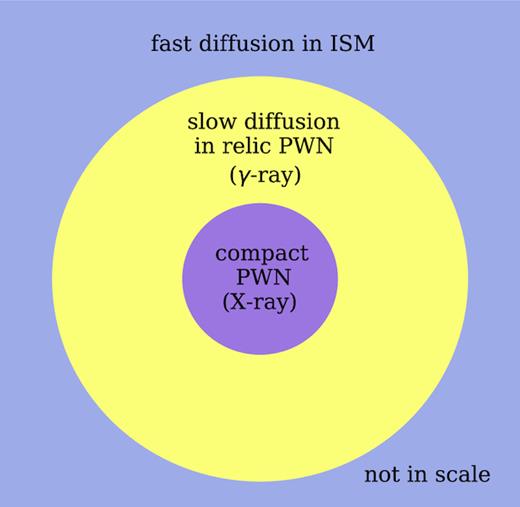
A schematic figure of particle transport in the Geminga PWN. The inner part of the PWN corresponds to the small bow shock nebula detected in X-ray and is unimportant in our model. The outer part of the PWN corresponds to the large nebula detected in γ-ray. Beyond the nebula, particles diffuse isotropically in the ISM where the diffusion coefficient is larger.
The diffusion coefficient in the relic nebula is expected to be smaller than that in the ISM, as the magnetic field in the nebula is higher and the magnetic topology is also more complicated. This naturally explains why the HAWC collaboration derived within the TeV emission region a diffusion coefficient much smaller than the ISM value. We propose that inefficient diffusion in the relic PWN of an old pulsar is likely to be a common phenomenon which can be tested by future γ-ray observation of other nearby pulsars.
4 γ-RAY SPECTRUM OF GEMINGA PWN
We turn now to calculate the IC emission of the Geminga PWN and compare it with the γ-ray data shown in Table 1
4.1 Energy losses
| photon field . | T(K) . | |$U\rm (eV\,cm^{-3})$| . |
|---|---|---|
| CMB | 2.7 | 0.26 |
| IR | 20 | 0.3 |
| Optical | 5000 | 0.3 |
| photon field . | T(K) . | |$U\rm (eV\,cm^{-3})$| . |
|---|---|---|
| CMB | 2.7 | 0.26 |
| IR | 20 | 0.3 |
| Optical | 5000 | 0.3 |
| photon field . | T(K) . | |$U\rm (eV\,cm^{-3})$| . |
|---|---|---|
| CMB | 2.7 | 0.26 |
| IR | 20 | 0.3 |
| Optical | 5000 | 0.3 |
| photon field . | T(K) . | |$U\rm (eV\,cm^{-3})$| . |
|---|---|---|
| CMB | 2.7 | 0.26 |
| IR | 20 | 0.3 |
| Optical | 5000 | 0.3 |
4.2 IC emission
The corresponding IC emission from both electrons and positrons are calculated with the naimapython package (Zabalza 2015), which implements the analytical approximations to IC scattering of blackbody radiation developed by Khangulyan, Aharonian & Kelner (2014). The formula remains accurate within 1 per cent over a wide range of energies.
In Figs 2 and 3, we compare the IC emission of the nebula with the γ-ray data for different injection spectrum and different initial pulsar periods. The upper panel depicts the differential number density E2N(E) of the electrons or positrons, while the lower panel depicts the corresponding IC emission. The MILAGRO, HAWC, and MAGIC data are illustrated with a black square, a circle, and an arrow, respectively. The single power-law model developed in Abeysekara et al. (2017a) overproduces the γ-ray emission in the GeV band even with the corrected MAGIC upper limit. In order to explain the MAGIC upper limit, we need either a broken power-law injection spectrum or a single power-law spectrum but with a larger initial period P0 as demonstrated in Figs 2 and 3, respectively.
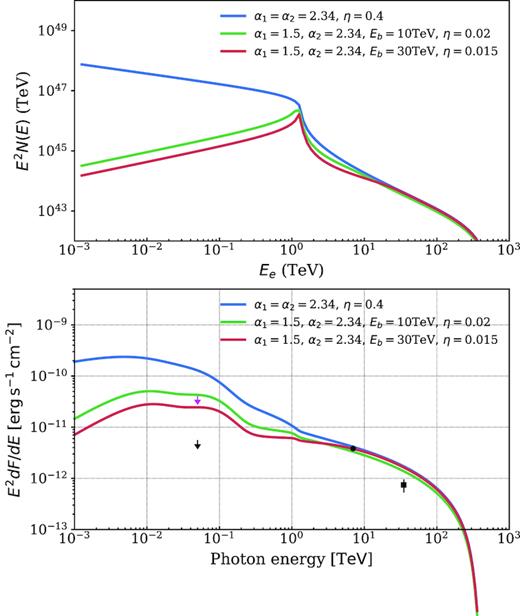
Upper panel: The differential number density E2N(E) as a function of the electron or positron energy for different α1 and α2. Lower panel: IC emission for different injection spectra. The black square and dot denote the MILAGRO and HAWC observations, respectively. The magenta and black arrows describe the corrected and uncorrected MAGIC upper limits, respectively.

Same as Fig. 2 but for a single power-law injection spectrum with different initial periods P0.
In the upper panel, the blue line shows a sharp drop around 1 TeV. This is mainly a reflection of the evolution history of the pulsar spin-down luminosity as indicated in equation (5). Electrons or positrons with energy |$E\gtrsim 1\rm TeV$| have a cooling time |$\tilde{t}_c(E_{\mathrm{ hi}}, E)\lesssim t_{\mathrm{ age}}-\tau _0$| and are injected at t0 ≳ τ0 accordingly. τ0, the initial spin-down time-scale, is much smaller than tage with the default P0. When t0 ≳ τ0, the pulsar spin-down luminosity decreases rapidly with t0. Hence, N(E) steepens with energy due to the decrease in the pulsar luminosity. If we increase the initial period P0, the sharp drop gradually disappears as shown in Fig. 3. This is because τ0 becomes comparable to tage and the pulsar spin-down luminosity becomes for a short while a constant in time. P0 ≳ 0.14 s is required to explain the MAGIC upper limit.
According to Figs 2 and 3, it is difficult to distinguish between the two explanations with only spectral information. The low-energy surface-brightness profile of the nebula is important to disentangle the two possibilities.
5 PARTICLE TRANSPORT AND SPATIAL DISTRIBUTION
We turn now to explore the spatial distribution of the electron–positron pairs and the positron flux on the Earth with a two zone diffusion model. The two zone diffusion model was studied by Fang et al. (2018) recently with numerical simulation. Here, we derive an analytical solution for the model, which involves a slow diffusion in the relic nebula and a fast diffusion in the ISM. The diffusion coefficient in the relic nebula is expected to be smaller than that in the ISM due to the larger magnetic field and the more complicated magnetic field topology.2 The two zone diffusion model can explain the small diffusion coefficient derived by Abeysekara et al. (2017a), as it corresponds to the value in the relic nebula instead of the ISM.
5.1 A single zone diffusion
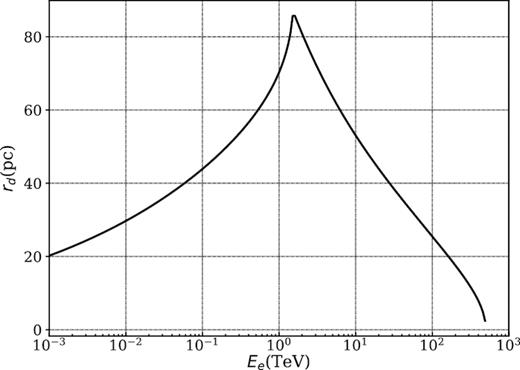
The diffusion length scale rd, defined in equation (16), as a function of the electron or positron energy with homogeneous diffusion.
5.2 Two zone diffusion
|$r_{\mathrm{ d}1}^3 H_2(r,E)$| is a dimensionless quantity, which depends on three dimensionless parameter r/rd1, b, and rb/rd1. Here, we are interested in the regime with b < 1 and rb/rd1 ≳ 1. Since the diffusion coefficient in the ISM is expected to be larger than that in the nebula. Under the assumption of rb = 60 pc, the diffusion length scale presented in Fig. 4 satisfies rd1 ≲ rb for the entire energy range.
In the upper panel of Fig. 5, we fix b and then investigate how does the spatial distribution of H2 vary with rb/rd1. As rb/rd1 increases the resulting profile gradually approaches the single zone solution. This is mainly because when rb ≫ rd1, the source is unable to feel the second zone. In the lower panel, we fix rb/rd1 and study how does H2 vary with b. For a given ratio of rb/rd1, when b decreases, particles can diffuse further away from the source. This helps to explain the observed positron excess. The effect is mainly important for the particles with rd1 ≈ rb = 60 pc, i.e. particles with energy around a few TeV (see Fig. 4). H2 approaches zero at small r/rd1 values because we adopt an absorption boundary at the source. It is not clear what should be the appropriate condition at the inner boundary. But we expect that the inner boundary condition has only small effects on the large-scale structure like the positron flux on the Earth.
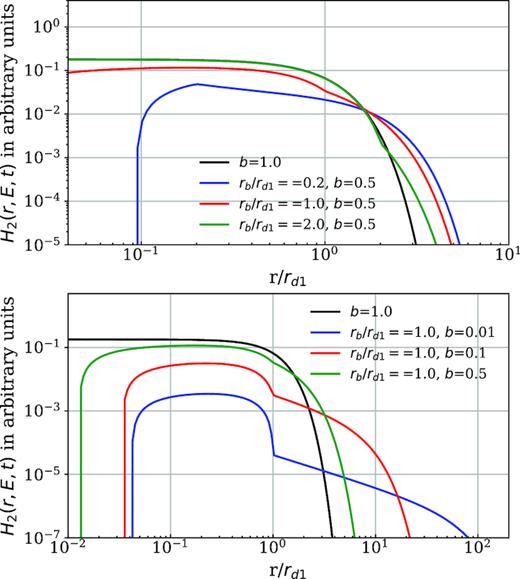
The two zone diffusion term H2(r, E, t) defined in equation (22) as a function of the dimensionless length scale r/rd1 for different combinations of b and rb/rd1. The black solid line is the result from a single zone diffusion with b = 1.
5.3 The surface brightness
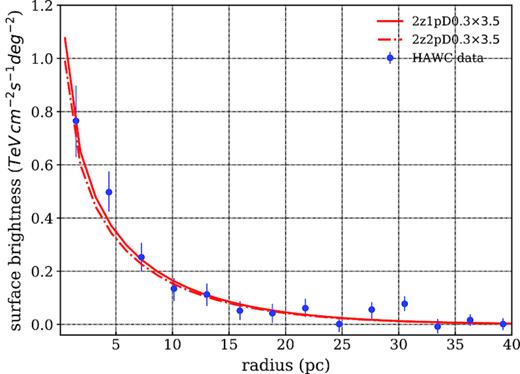
Surface-brightness profiles between 5 and 50 TeV of the photon energy. The HAWC data are taken from Abeysekara et al. (2017a) and the HAWC model is calculated with the same parameter as in Abeysekara et al. (2017a). 2z1pD03 and 2z2pD03 are the single power-law and broken power-law model, respectively.
In Fig. 6, we compare the HAWC data with different model results. The physical paramters applied in the different models are listed in Table 4. The ‘HAWC’ model is calculated with the same parameter as in Abeysekara et al. (2017a). ‘2z1pDx’ stands for a two zone diffusion model with a single power-law injection spectrum and D1/D2 = x, while ‘2z2pDx’ denotes two zone diffusion model with a broken power-law injection spectrum and D1/D2 = x. Since we adopt rb = 60 pc, which is larger than the size of observed γ-ray nebula, the two zone diffusion model produces almost the same surface-brightness profile as the single zone model within rb. Within the two zone model the surface-brightness profile at radius r ≲ 20 pc is insensitive to the D1/D2 ratio. Hence, models with D1/D2 = 0.05 and 0.01 are not plotted in Fig. 6.
| Model name . | α1 . | α2 . | Eb (TeV) . | |$D_1(10^{27}\,\rm cm^2\,s^{-1}$|) . | D1/D2 . | rb(pc) . | P0 (s) . | η . | B (μG) . | Emin (TeV) . | Emax(TeV) . |
|---|---|---|---|---|---|---|---|---|---|---|---|
| HAWC | 2.34 | 2.34 | – | 4.5 | 1 | – | 0.045 | 0.4 | 3 | 10−3 | 500 |
| 2z1pD03 | 2.34 | 2.34 | – | 4.5 | 0.3 | 60 | 0.14 | 0.4 | 3 | 10−3 | 500 |
| 2z1pD005 | 2.34 | 2.34 | – | 4.5 | 0.05 | 60 | 0.14 | 0.4 | 3 | 10−3 | 500 |
| 2z1pD001 | 2.34 | 2.34 | – | 4.5 | 0.01 | 60 | 0.14 | 0.4 | 3 | 10−3 | 500 |
| 2z2pD03 | 1.5 | 2.34 | 30 | 4.5 | 0.3 | 60 | 0.045 | 0.015 | 3 | 10−3 | 500 |
| 2z2pD005 | 1.5 | 2.34 | 30 | 4.5 | 0.05 | 60 | 0.045 | 0.015 | 3 | 10−3 | 500 |
| 2z2pD001 | 1.5 | 2.34 | 30 | 4.5 | 0.01 | 60 | 0.045 | 0.015 | 3 | 10−3 | 500 |
| Model name . | α1 . | α2 . | Eb (TeV) . | |$D_1(10^{27}\,\rm cm^2\,s^{-1}$|) . | D1/D2 . | rb(pc) . | P0 (s) . | η . | B (μG) . | Emin (TeV) . | Emax(TeV) . |
|---|---|---|---|---|---|---|---|---|---|---|---|
| HAWC | 2.34 | 2.34 | – | 4.5 | 1 | – | 0.045 | 0.4 | 3 | 10−3 | 500 |
| 2z1pD03 | 2.34 | 2.34 | – | 4.5 | 0.3 | 60 | 0.14 | 0.4 | 3 | 10−3 | 500 |
| 2z1pD005 | 2.34 | 2.34 | – | 4.5 | 0.05 | 60 | 0.14 | 0.4 | 3 | 10−3 | 500 |
| 2z1pD001 | 2.34 | 2.34 | – | 4.5 | 0.01 | 60 | 0.14 | 0.4 | 3 | 10−3 | 500 |
| 2z2pD03 | 1.5 | 2.34 | 30 | 4.5 | 0.3 | 60 | 0.045 | 0.015 | 3 | 10−3 | 500 |
| 2z2pD005 | 1.5 | 2.34 | 30 | 4.5 | 0.05 | 60 | 0.045 | 0.015 | 3 | 10−3 | 500 |
| 2z2pD001 | 1.5 | 2.34 | 30 | 4.5 | 0.01 | 60 | 0.045 | 0.015 | 3 | 10−3 | 500 |
Note. D1 is at 100 TeV.
| Model name . | α1 . | α2 . | Eb (TeV) . | |$D_1(10^{27}\,\rm cm^2\,s^{-1}$|) . | D1/D2 . | rb(pc) . | P0 (s) . | η . | B (μG) . | Emin (TeV) . | Emax(TeV) . |
|---|---|---|---|---|---|---|---|---|---|---|---|
| HAWC | 2.34 | 2.34 | – | 4.5 | 1 | – | 0.045 | 0.4 | 3 | 10−3 | 500 |
| 2z1pD03 | 2.34 | 2.34 | – | 4.5 | 0.3 | 60 | 0.14 | 0.4 | 3 | 10−3 | 500 |
| 2z1pD005 | 2.34 | 2.34 | – | 4.5 | 0.05 | 60 | 0.14 | 0.4 | 3 | 10−3 | 500 |
| 2z1pD001 | 2.34 | 2.34 | – | 4.5 | 0.01 | 60 | 0.14 | 0.4 | 3 | 10−3 | 500 |
| 2z2pD03 | 1.5 | 2.34 | 30 | 4.5 | 0.3 | 60 | 0.045 | 0.015 | 3 | 10−3 | 500 |
| 2z2pD005 | 1.5 | 2.34 | 30 | 4.5 | 0.05 | 60 | 0.045 | 0.015 | 3 | 10−3 | 500 |
| 2z2pD001 | 1.5 | 2.34 | 30 | 4.5 | 0.01 | 60 | 0.045 | 0.015 | 3 | 10−3 | 500 |
| Model name . | α1 . | α2 . | Eb (TeV) . | |$D_1(10^{27}\,\rm cm^2\,s^{-1}$|) . | D1/D2 . | rb(pc) . | P0 (s) . | η . | B (μG) . | Emin (TeV) . | Emax(TeV) . |
|---|---|---|---|---|---|---|---|---|---|---|---|
| HAWC | 2.34 | 2.34 | – | 4.5 | 1 | – | 0.045 | 0.4 | 3 | 10−3 | 500 |
| 2z1pD03 | 2.34 | 2.34 | – | 4.5 | 0.3 | 60 | 0.14 | 0.4 | 3 | 10−3 | 500 |
| 2z1pD005 | 2.34 | 2.34 | – | 4.5 | 0.05 | 60 | 0.14 | 0.4 | 3 | 10−3 | 500 |
| 2z1pD001 | 2.34 | 2.34 | – | 4.5 | 0.01 | 60 | 0.14 | 0.4 | 3 | 10−3 | 500 |
| 2z2pD03 | 1.5 | 2.34 | 30 | 4.5 | 0.3 | 60 | 0.045 | 0.015 | 3 | 10−3 | 500 |
| 2z2pD005 | 1.5 | 2.34 | 30 | 4.5 | 0.05 | 60 | 0.045 | 0.015 | 3 | 10−3 | 500 |
| 2z2pD001 | 1.5 | 2.34 | 30 | 4.5 | 0.01 | 60 | 0.045 | 0.015 | 3 | 10−3 | 500 |
Note. D1 is at 100 TeV.
We multiply our results by a factor of 3.5 when comparing the HAWC data. It is because when we apply the same parameter as in Abeysekara et al. (2017a), we found that the resulting γ-ray flux is consistent with the value based on the disc template,3 see the supplementary fig. 2 in Abeysekara et al. (2017a). The surface-brightness data however appear to agree with the value estimated with a diffusion template, which is larger than the disc template’s value by a factor about 3.5. This discrepancy will not affect the discussion with broken power-law injection spectrum, as we can simply increases the acceleration efficiency by the same factor. Larger γ-ray flux of the Geminga PWN does make it difficult for the model with a single power-law injection spectrum to interpret the surface-brightness data as the current η = 0.4.
5.4 The positron flux at the Earth
Fig. 7 depicts the number density of positrons, N2(r, E), as a function of the radius r at energy E = 1 TeV. We focus on two different situations, a single power-law injection spectrum with a larger initial period P0 and a broken power-law spectrum with a smaller P0. This is illustrated in the upper panel and the lower panel, respectively. The basic parameters for all the different models are listed in Table 4.
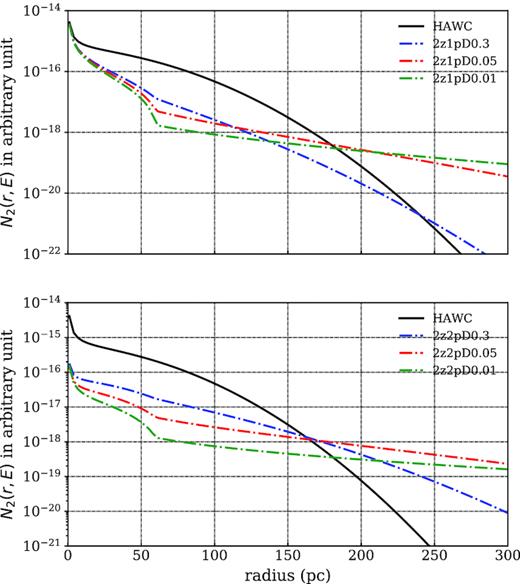
The differential number density of positron (or electron), N2(r, E), as a function of distance r at energy |$E=1\,$| TeV. A single power law with a larger initial period P0 (upper panel). A broken power-law injection spectrum with a smaller P0 (lower panel). The black solid line represents the model from Abeysekara et al. (2017a).
When the D1/D2 ratio decreases, the positron flux at the Earth (assuming d = 250 pc) increases as the Earth position is shifted from the exponential tail to the plateau region in the spatial distribution (see Fig. 7). The positron flux reaches a maximum at D1/D2 ∼ 0.05 and it is boosted by more than 2 orders of magnitude compared with the single zone model results. When the D1/D2 ratio decreases further, the positron flux at the Earth decreases as the normalization constant of the plateau region becomes smaller.
Fig. 8 depicts the positron spectrum produced by the Geminga pulsar at the Earth for the different models shown in Fig. 7. The single power-law model produces a flat positron spectrum at Earth, which seems to be more consistent with data.4 However, the broken power-law model cannot be ruled out. If D1/D2 ∼ 0.05, both the single power-law model and the broken power-law model can contribute a significant fraction of the positron excess above ∼300 GeV. It is worth noting that all the models discussed here are not meant to be the best fit for the positron flux data but mainly for illustration. As it is difficult to explore the whole parameter space. Future γ-ray observations in the GeV band will enable us to put strong constraints on the model set up and narrow the parameter space. Positron flux from other nearby pulsars also need to be investigated in future study.
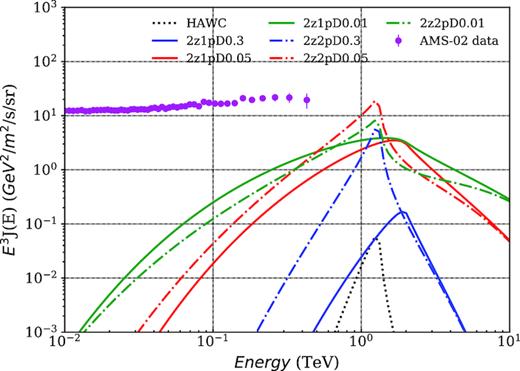
The positron flux at the Earth produced by the Geminga pulsar with different model setup listed in Table 4.
5.5 The proper motion of the Geminga pulsar
The proper motion of the Geminga pulsar is mainly important for the surface-brightness profile of the PWN at low energies Ee ≲ 1 TeV. In the TeV band, the morphology of the nebula is found to be not strongly affected by the proper motion. Because the corresponding electron–positron pairs have a smaller lifetime and the corresponding transverse motion of the pulsar is smaller than that estimated in equation (29). It is consistent with the roughly spherical symmetric nebula revealed in the HAWC observations (Abeysekara et al. 2017a). In the lower energy band, where the lifetime of electrons–positron pairs are close to tage, a bow shock nebula morphology is instead expected, and indeed observed in X-rays (Caraveo et al. 2003). In Fig. 9, we present the surface-brightness profile of the Geminga PWN between 50 and 100 GeV that is relevant for the MAGIC band with the set-up of the HAWC model. The nebula is elongated in the negative x-direction due to the proper motion. Within the single zone model, the proper motion of the pulsar has a limited influence on the positron flux at Earth, as it only changes the distance of the pulsar slightly introducing an effect |${\lesssim } (v_tt_{\mathrm{ age}}/d)^2 \approx 10{{\ \rm per\ cent}}$|.
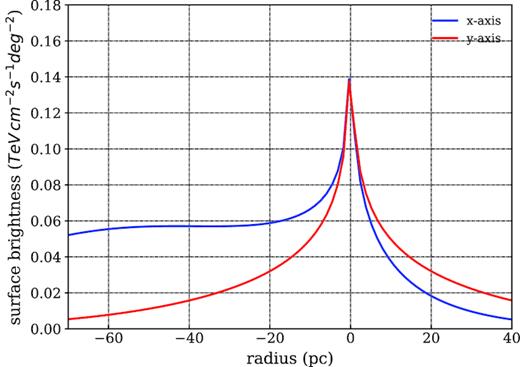
The surface-brightness profile between 50 and |$100\,$| GeV (i.e. the MAGIC band) both along the proper motion direction (x-axis) and perpendicular to the proper motion direction in the plane of sky (y-axis).
6 DISCUSSION
We propose that the γ-ray emission detected by HAWC and MILAGRO in the direction of Geminga originated from the relic PWN surrounding the pulsar. We developed a two zone diffusion model with a slow diffusion D1 in the PWN and a fast diffusion D2 in the ISM. This model would explain both the surface-brightness profile and the positron excess ≳300 GeV. With D1/D2 ∼ 0.05, the Geminga pulsar can supply a significant fraction of the positron excess above ∼300 GeV. The diffusion coefficient in the ISM is |$D_{\mathrm{ ISM}}\sim 2\times 10^{27}\,\rm cm^2\,s^{-1} (\mathit{ E}/1\,GeV)^{1/3}$|. This value is one order of magnitude smaller than the standard value but more consistent with the low value required in the spiral arm model for the CR propagation (e.g. Shaviv et al. 2009).
There are several factors that can affect the γ-ray emission and the surface-brightness profile of the Geminga PWN and the positron flux at Earth. The MAGIC upper limit implies either a broken power-law injection spectrum or a single power law but with a larger initial period P0. This can be tested by future multiwavelength observation. We assume that the particle acceleration efficiency η is a constant. If instead η gradually decreases with time, then our calculation underestimates the positron flux from the Geminga pulsar. This helps to relieve the discrepancy between the HAWC detection (Abeysekara et al. 2017a) and the idea that the Geminga pulsar is a main source of the positron excess. The proper motion of the Geminga pulsar was studied with a single zone model. We found that a bow shock nebula morphology likely has appeared in the GeV emission. This can be tested by future MAGIC observation.
The main caveat of our model is that we neglect the dynamical evolution of the PWN and focus only on the time evolution of the pulsar spin-down power. In other words, we investigate a model with a dynamical pulsar and a static nebula with time-independent diffusion coefficient and magnetic field. The peak of the positron flux on the Earth corresponds to the pairs injected at an early phase of the Geminga pulsar, when the pulsar spin-down luminosity was still large. Therefore, the understanding of the diffusion of TeV pairs in young PWNe, like the Crab, is crucial for explaining the observed positron excess at ≳300 GeV. The slow diffusion revealed by Abeysekara et al. (2017a) in the γ-ray emission region instead characterizes the properties of the relic nebula at the late phase and is likely irrelevant.
In summary, by considering a physically motivated PWN model for the γ-ray observation of HAWC and MILAGRO we have shown that the Geminga pulsar is a good candidate to be source of a significant fraction of the observed positron excess at ≳300 GeV .
ACKNOWLEDGEMENTS
We thank Nir Shaviv and Reetanjali Moharana for helpful discussions. The research was supported by an ERC advanced grant TReX and by the CHE-ISF I-CORE center for excellence.
Footnotes
Note however that in the standard model ad hoc re-acceleration or winds are needed to explain the very low-energy behaviour (Strong et al. 2007).
Note that for simplicity when calculating the cooling we take the magnetic field to be the same in the PWN and in the ISM
Note that in the spiral arm model the pulsars contribute only to the higher end of the excess.
REFERENCES
,
APPENDIX A: THE PARTICLE DISTRIBUTION FOR TWO ZONE DIFFUSION
In this appendix, we derive the particle distribution for a two zone diffusion model using the solution of single zone diffusion. We denote by subscript 1 a single zone diffusion and subscript 2 a two zone diffusion.



